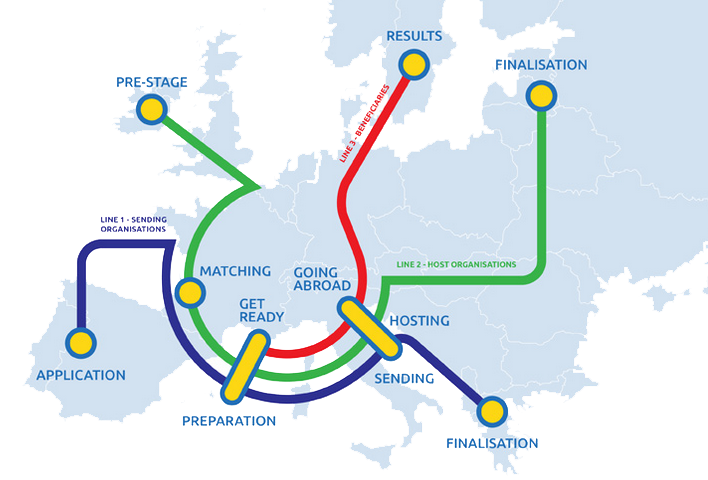Why EU Mobility?
Getting work experience abroad is a significant factor in professional and personal development. Especially in the context of a European labour market that requires flexibility and intercultural knowledge.
Participation in mobility projects offers a unique chance! Participants can spend a certain period of time in another country and gain valuable life-skills and international experience to help them develop personally and professionally.
In recent years the European Commission has supported mobility in many ways, by introducing the free movement of workers, by systems that allow greater transparency in qualifications between countries (ECVET) and by funding possibilities like Erasmus+.
The European Knowledge Center explains you step by step how to manage successful mobility projects.
We therefore invite you to take part in a journey and start your itinerary:
- The blue line for sending organisations and coordinators on the sending side
- The green line for hosting organisations and coordinators on the hosting side
- The red line for beneficiaries – learners or staff.
There will be many tasks for all persons and organisations involved. Sometimes they are specific, sometimes you need to do common arrangements. For both cases, at the following pages we give you useful tips, checklists, templates and many other exciting resources.
Enjoy your journey to a successful mobility project!

First some background information
What is Erasmus+?
 Erasmus+ is the EU’s programme to support education, training, youth and sport in Europe. In Key Action 1 (KA1) it supports the mobility of learners and staff in higher education, vocational education and training (VET), schools, adult education and youth.
Erasmus+ is the EU’s programme to support education, training, youth and sport in Europe. In Key Action 1 (KA1) it supports the mobility of learners and staff in higher education, vocational education and training (VET), schools, adult education and youth.
Organisations can provide opportunities for both apprentices and students to learn abroad in a workplace or at a VET school. Staff can be sent to an enterprise or organisation to teach, train, or be trained.
Organisations wanting to take part in these opportunities can either apply as an individual vocational education organisation, or as part of a “national mobility consortium”; a group of organisations managed by a single coordinating organisation.
The application process is managed by the National Agency of where the applicant organisation or the consortium is based.
Eligible applicant organisations
The eligibility certainly depends on the field you want to apply in, it can be Universities, schools in general education… but as we focus on vocational education and training, the eligible organisations are:
- Any public or private organisation (or its subsidiary/branch) active in the field of vocational education and training (referred to as a VET provider); or
- Any public or private organisation active in the labour market (referred to as a company)
Examples: Vocational schools, small, medium or large enterprises, a public body, non-profit organisations, bodies providing career guidance, professional counselling and information services, schools at any level from pre-school to adult education etc.
Each organisation must be established in a Programme Country.
Organisations involved and information flows
Have a look at the two videos to get to know about the organisations involved as well as their necessary interaction and communication flows:
From the point of view of a sending organisation: |
From the point of view of a hosting organisation: |
Eligible activities
A VET mobility project must comprise one or more of the following activities:
- Mobility in VET providers and/or companies abroad, from 2 weeks to less than 3 months;
- Long-term mobility in VET providers and/or companies abroad (ErasmusPro), from 3 to 12 months.
- Teaching/training assignments abroad;
- Staff training abroad.
Further information
For any other information you can consult experts at your ![]() ERASMUS+ National Agency
ERASMUS+ National Agency
Check the ![]() Erasmus+ Programme Guide for important information about project management
Erasmus+ Programme Guide for important information about project management
